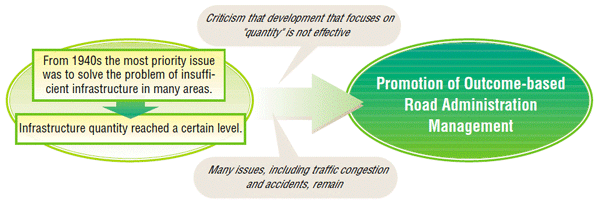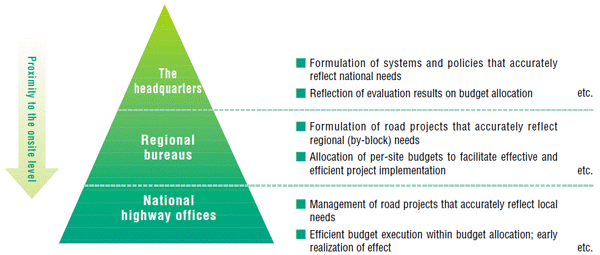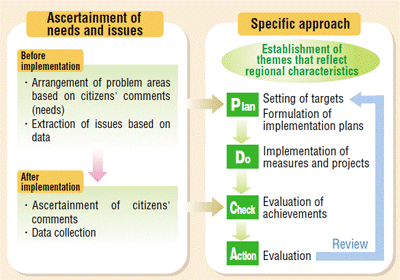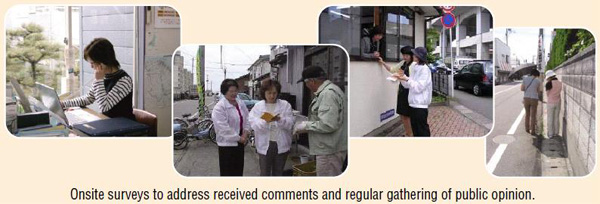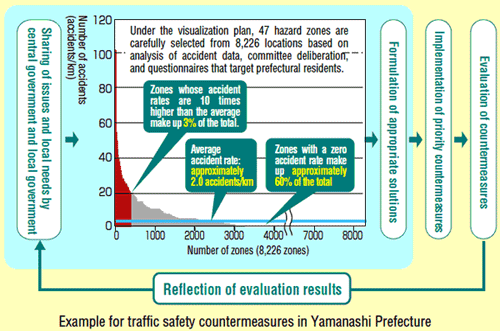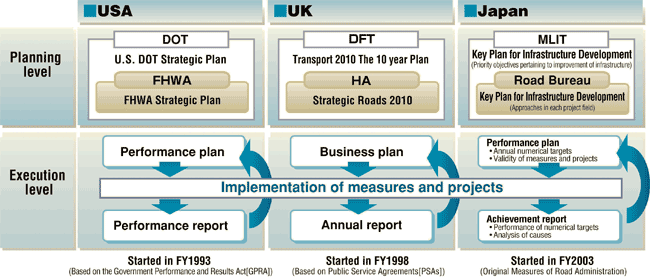 |
■ Performance Management of Road Administration in Japan
Outcome-based Road Administration Management in Japan
1. Outcome-based Road Administration Management
The Road Administration Management approach was begun from FY2003 to promote a shift toward more efficient, effective, and highly transparent road administration.
■Management based on agency role
The headquarters, Regional bureaus, and National highway offices are practicing Outcome-based Road Administration Management, with the PDCA cycle, based on the missions and roles of each organization, in order to accurately respond to issues and needs at the national, regional, and local levels.
■Management at National highway offices level
National highway offices―which serve as local service windows-- implement the PDCA cycle to arrange problem areas based on citizens' comments (needs), clarify local problems based on data, establish themes that reflect local characteristics, and formulate more effective and efficient countermeasures based on targets established to address these themes as well as detailed data.
2. Promotion of road administration through cooperation with citizens
Approaches designed to precisely meet public needs are being promoted through cooperation with civic organizations, such as NPOs.
- In partnership with NPOs and other civic organizations, road measures are implemented in a collaborative manner with National highway offices at all stages of the PDCA cycle.
- In the area of road management, continued assistance is extended to Volunteer Support Programs (VSP) and other schemes, while a variety of approaches are used to extract regional needs through cooperation with NPOs and other civic organizations.
|
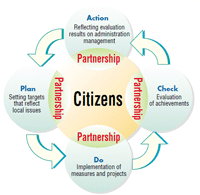 |
Case example : the "Michi no Nandemo Sodan Hiroba (Road Counseling Plaza)" (Hokuriku Regional Bureau)
The Niigata National Highway Office has linked with the NPO women's network for roads in Koshi to establish the "Michi no Nandemo Sodan Hiroba (Road Counseling Plaza)", which gathers comments and concerns relating to all roads in the Kaetsu Region (including national highways, prefectural roads, and municipal roads), and to engage in finetuned activities to put the comments that are received to use in road administration.
3. Promotion of management through collaboration with local government
Aiming for more efficient road management, the central government and local government
share issues and needs in each region, work together to study appropriate solutions, and implement countermeasures, beginning with high-priority problems.
Case example : Visible Performance Management for Road Administration (Kanto Regional Bureau)
The Kanto Regional Bureau is promoting the "Visible Performance Management for Road Administration". With focus on road mobility and safety, National highway offices and the nine prefectures under the bureau's jurisdiction collaborate to carefully select areas that require countermeasures based on data and public opinions, study causes and solutions, and promote approaches toward implementation of countermeasures (beginning with those of the highest priority). In charge of these activities is a committee made up of academic experts, road users, and others.
4. The Undertakings of Road Administration Management
FY 2003 |
- The numerical target is set up every year, such as reducing national traffic congestion time 3% in one year, and the "result-oriented" administration management which evaluates the achievement level subsequently started to be promoted.
|
FY 2004 |
- The first “Achievement Report” was drawn up and the achievement level of the target declared one year ago was checked. The evaluation and the knowledge which were acquired by the “Achievement Report” were reflected to the following policies and following projects.
|
FY 2005 |
- Released the "Achievement Report" and the "Performance Plans" in June.
- Hereafter, a road administration management will be familiarized to local areas, thus it will be certainly practiced.
|
FY 2006 |
- Released the "Achievement Report" and "Performance Plans" in June.
|
5. Outcome-based Undertakings in Other Countries
Since the 1980s, several countries, including the US and UK, have been promoting administrative reform called "New Public Management" (NPM), in which private-sector management approaches are incorporated into administration, in order to ensure efficient administration.
In NPM, policy objectives are set using outcome indicators (i.e., indices expressing results), performance is analyzed and assessed every year, and the results are reflected in future policies and projects.
Example of Undertakings for Road Administration Management
Policy theme: Maintaining the functions of roads -Extending the lifetime of road structures through appropriate road management-
Indicator: Ratio of bridges receiving preventative maintenance
(1) Background and necessity
- Old aged road facilities that were built during Japan's period of high economic growth are quickly increasing. The number of bridges that are more than 50 years old will increase threefold in 10 years and seven-fold in 20 years.
- If left as is, bridges that are increasing degrees of the "three major types of damage" (fatigue, salt corrosion, and alkali-aggregate reaction) will present a growing risk to safe passage or require major repairs in several years. Thus, because the possibility of a major incident occurring exists, it is important to make preventative repairs when damage is still minor.
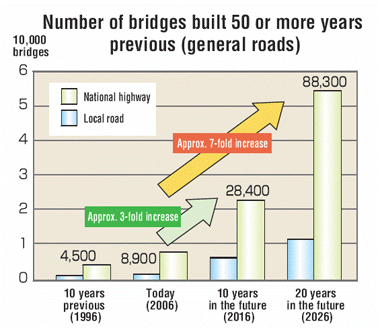
(2) Approaches taken in FY2005 and their results
- While enhancing data pertaining to bridge inspection results and repair records, trial operation of a preventative maintenance support system was implemented together with efforts to reinforce management.
- Studies were taken on repair and reinforcement measures for bridges suffering from the "three major types of damage," with opinions provided from experts as needed. Measures were implemented on 175 bridges.
(3) Approaches taken in FY2006
- New indicators for evaluating average extended lifetime as well as lifetime extension benefit will be studied and developed, and preventative maintenance management will be practiced and reinforced.
(4) Case example
-Implementation of necessary maintenance and repairs at appropriate times-
Because of the possibility that required funding will grow in line with the rapidly aging road stock, it will be necessary to promote systematic management that is based on current conditions and future estimates. For example, knowing that appropriate maintenance can allow a bridge to be used for 100 years, preventative maintenance will be practiced to extend bridge life and lower repair and rebuilding cost.
|
Implementation of necessary maintenance and
repairs at appropriate times

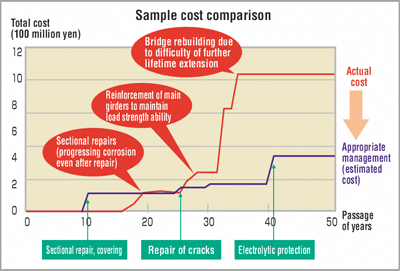
|
|
Examples of bridge damage

Pronounced corrosion of steel girders
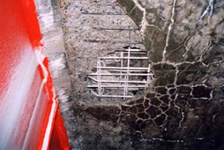
Falling concrete slabs
|
Policy theme: Facilitating road traffic -Promotion of effective Measures to Deal with Traffic Congestion-
Indicator: Time loss due to traffic congestion
(1) Background and necessity
- Nationwide, 3.81 billion people hours are lost to traffic congestion (equivalent to approximately 12 trillion yen after monetary conversion). Some 80% of this lost time is concentrated in areas around prefectural capitals.
- Not only does traffic congestion lower economic efficiency, it also has an impact on the global environment as a source of CO2 emissions.
 National total: 3.8 billion people hours *Actual result for FY2002
(2) Approaches taken in FY2005 and their results
- In each region, various approaches were tried that included combining objective data with resident questionnaires and extraction of points requiring countermeasures. Some 2,200 major congestion points were identified as requiring countermeasures.
- Management that can respond at the local level was practiced. This included study and implementation of methods other than road improvement in response to onsite conditions.
- Congestion countermeasure, such as road improvement (putting into service approximately 172 km of National highways and approximately 78 km of National expressway in FY2005), reduced nationwide time loss due to traffic congestion to 3.51 billion people hours in FY 2005)
(3) Approaches taken in FY2006
- For major congestion points and other congestion points identified through the views of road users, congestion countermeasures will be promoted by considering "the congestion countermeasure program".
- "Mobility management" that considers cost effectiveness will be conducted in some 10 districts nationwide.
- Budgetary priority will continue to be placed on severely congested areas.
(4) Case example
-Congestion countermeasures from "Entrance of Wakayama univ." intersection to Umehara intersection.
Wakayama National Highway Office National Highway Route 26 Wakayama City-
In the evening, chronic congestion occurred from Umehara intersection toward Wakayama City in Route 26. In order to alleviate this situation, the number of lanes in the direction of Wakayama (southbound) was increased from one to two from the "Entrance of Wakayama univ." intersection to Umehara intersection, while the number of lanes in the direction of Osaka (northbound) was reduced from two to one. While this change resulted in increasing congestion in the northbound lane during the morning hours, such congestion was alleviated by changing traffic phase and extending the merging section.
| [ Location map ] |
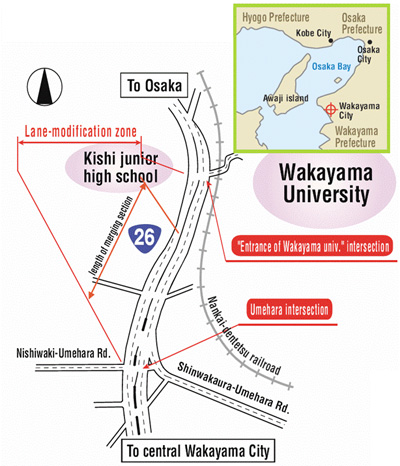 |
| [ Implementation of countermeasures ] |
[ Verifying countermeasure results ] |
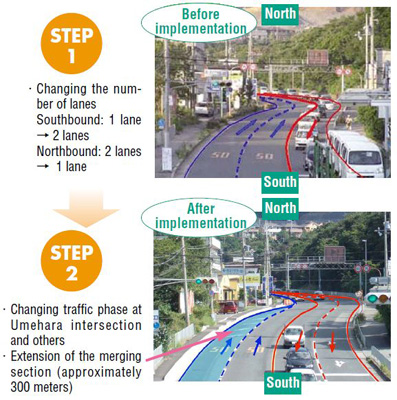 |
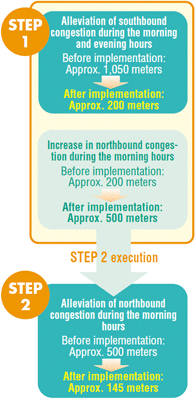 |
Policy theme: Maintenance of safe and worry-free roads -Controlling accidents on trunk roads and maintaining safe and worry-free pedestrian spaces on community roads-
Indicator: Road traffic accident casualty rate
(1) Background and necessity
- Although the number of people killed in traffic accidents in 2005 fell to approximately 6,800, the number of accident casualties remained over 1 million people.This represents a serious situation in which approximately one in 100 citizens will be killed or injured in an accident.
- Fifty three percent of traffic accidents on Japan's trunk roads (non-intersection locations) are concentrated in zones comprising 6% of road length. Thus, concentrated measures will be needed that put priority on zones with high accident casualty rates.
- Of all traffic accident fatalities, approximately 40% involved pedestrians or people riding on bicycles. This is a high figure compared to other countries.
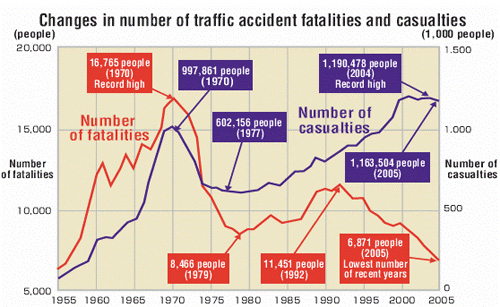
(2) Approaches taken in FY2005 and their results
- Measures were taken based on scientific analyses using the "Priority Indication System" and the "Manual on traffic accident countermeasures and their evaluation."
- Concentrated measures were taken in "High Accident Risk Locations," in which accidents occur on trunk roads repeatedly, and in "Safe Walking Areas," that is high probability of accident on community roads.
- The number of accidents in High Accident Risk Locations that countermeasures had been nearly completed in FY2003 were reduced by roughly 30%.
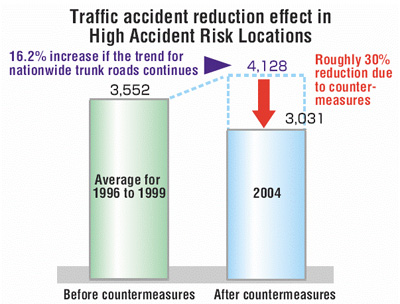 |
|
Safe Walking Areas
Districts that are residential or commercial districts with high casualtycausing accident rates and that have trunk roads on their outer edges
|
(3) Approaches taken in FY2006
- Zones having high casualty rates will be extracted and priority traffic accident countermeasures will be taken (countermeasures against High Accident Risk Locations, etc.). Individual countermeasures will be promoted according to scientific analysis.
- Establishment of pedestrian-friendly roads will be promoted in a spatial and comprehensive manner. This will include establishment of sidewalks, etc., that are matched to speed regulations of public safety commissions.
(4) Case example
-Example of traffic safety countermeasures that are based on public involvement. "Road Inspection Report" of the Kanazawa Office of River and National Highway-
Civic organizations, PTAs, and road administrators worked together to conduct onsite surveys of safe and comfortable as well as hazardous areas, and prepared the "Traffic Safety Map for Cyclists and Pedestrians" with the participation of elementary and junior high school students and their parents. Based on the results of this project, concerned parties discussed feasible improvement measures and undertook sequential improvements, beginning with areas having urgent need for countermeasures, with the goal of completing improvements at hazardous areas within three years.
At the same time, the "Road Inspection Report" that allows visitors to check the progress of these countermeasures anytime is made available to the public via the Internet.
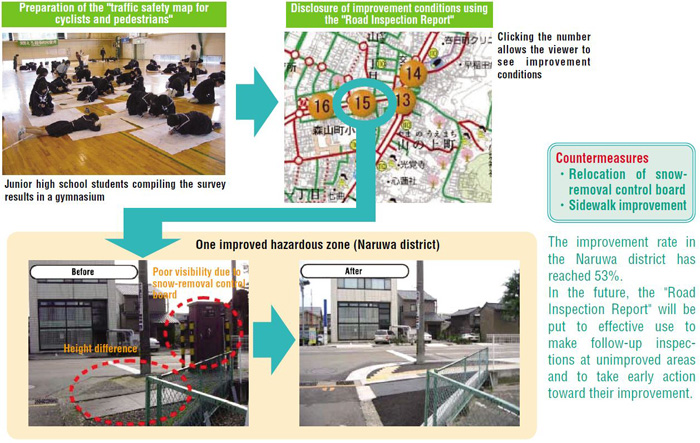
Policy theme: Facilitating road traffic - Accelerating railroad crossing countermeasures-
Indicator: Time loss due to closed railroad crossings
(1) Background and necessity
- Some 36,000 railroad crossings exist in Japan (Tokyo has 699 crossings, compared to 14 in Paris, a city of comparable size). These crossings are a major cause of traffic congestion.
- In FY2004, some 260 people were either killed or injured at railroad crossings. Still fresh in the memory is a tragic accident that occurred at a crossing on the Tobu Isezaki Line in March 2005. These and other factors prove that perpetually closed crossings are becoming a serious social issue.
- "Perpetually closed crossings" involve an extremely broad range of issues due to their impact on crossing traffic safety and community division. Thus, approaches that employ prompt measures are urgently needed at crossings for which more drastic measures will take time.
- Number of crossings

- Number of crossing accidents (FY2004)

(2) Approaches taken in FY2005 and their results
- In FY2005, 62 crossings were eliminated through drastic measures (building of grade separations, etc.). This helped eliminate or improve the traffic congestion and crossing accident situation.
- Up to FY2005, measures that include building of grade separations (drastic measure) as well as building of cross-grade facilities, widening of sidewalks, and introduction of "smart" crossings (prompt measures) were undertaken at 109 perpetually closed crossings.
(3) Approaches taken in FY2006
- An inspection of railroad crossing conditions in all areas of Japan will be conducted to clarify those crossings that require emergency countermeasures. Then a five-year improvement plan will be formulated for used as the basis for smooth work execution.
- Based on the improvement plan, comprehensive measures will be promoted that will include "prompt measures," such as widening of sidewalks, and "drastic measures," such as building continuous grade separation.
(4) Case example
-Example of countermeasures against "perpetually closed crossings". Project to build a continuous grade separation on the Kintetsu Nagoya Line and JR Kansai Main Line-
Complete removal of railroad crossings by elevating railroad lines for approximately 3.5 kilometers
around Hatta Station through a continuous grade separation project for the Kintetsu Nagoya Line and the JR Kansai Main Line (switch to elevated lines made in May 2005) produced the following benefits.
- Elimination of traffic congestion: Traffic congestion that occasionally stretched back 400 meters was eliminated.
(Kasumori No. 1 crossing side)
- Elimination of community division: Crossing closure that could extend to approximately 13 hours a day was eliminated.
(Kasumori No. 1 crossing and Nakamura street crossing)
- Elimination of crossing accidents: Crossing accidents--which had occurred on 13 occasions and lead to four deaths between 1994 and May 2005--were eliminated through the switch to elevated lines (project distance: 3.5 kilometers).
| [ Location map ] |
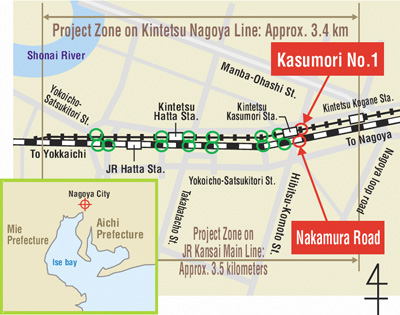 |
| [ Examples of benefit ] |
Situation at Kasumori No.1 crossing (before and after line elevation)
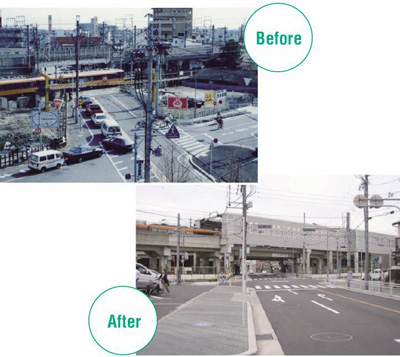 |
Early generation of project effects by reinforcing project progress management
(1) Background and necessity
- There are instances where road projects take longer than was originally planned due to coordination of related interests and various uncertainties. This results in dissatisfaction among citizens, who have no way of knowing when a particular road will be completed.
- National government projects are managed to generate the early project effects. These projects must have an environment that fosters smooth progress (e.g., "framework for local cooperation is established", "project site likely to be secured" etc.) and a feasible completion of five years or less. Also, completion targets, project progress targets, and level of target achievement for each fiscal year must be announced, and thorough management of project progress and cost must be conducted.
(2) Approaches taken in FY2005 and their results
- The Kyushu Regional Bureau implemented projects under its "Chaku Chaku Project 2005" scheme by announcing completion targets and progress targets for 540 zones and sites. Of the 174 zones and sites for which completion targets were announced in FY2005, 156 zones and sites (89.7%) achieved their targets.
- The Tohoku Regional Bureau implemented projects under its "Road Improvement with a 5-Year Vision" scheme by announcing completion targets and progress targets for 114 zones and sites. Of the 21 zones and sites for which completion targets were announced in FY2005, 18 zones and sites (85.7%) achieved their targets.
(3) Approaches taken in FY2006
- The progress of projects will be accelerated by announcing completion targets, progress target and levels of target achievement for each fiscal year, and by engaging in progress management.
(4) Case example
-Approach of the "Target Declaration Project" Kyushu Regional Bureau: "Chaku Chaku Project" National Highway Route 208 Ariake Coastal Road (Length = 27.5 km)-
The announcement of an completion target of FY2007 for the Ariake Coastal Road under the "Chaku Chaku Project 2003" scheme accelerated cooperation with local governments and other bodies, helped realize the formation of community agreements at an early stage, and significantly promoted acquisition of project sites.
| [ Location map ] |
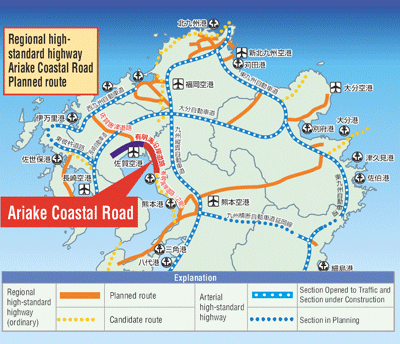 |
| [ Sign board for announcement of completion target. ] |
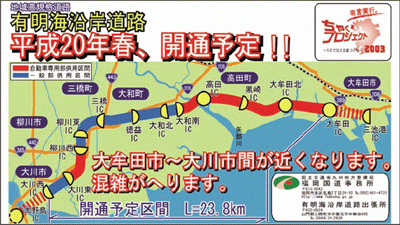 |
"Sign board shows "Ariake Coastal Road between Omuta Interchange and Okawa-nishi Interchange, 23.8km scheduled opening in spring 2008!!" |
| [ Outline of effects ] |
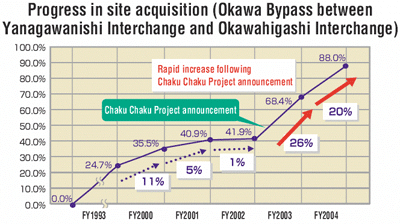 |
- Significant progress in acquiring project sites (Okawa Bypass [from 41.9% to 88.0% between Yanagawanishi Interchange and Okawahigashi Interchange])
- Okawa City established a "national/prefectural highway promotion office" in FY2004 to support the Ariake Coastal Road project.
|
Management in toll road projects
With priority on an agreement (see note) to work toward an appropriate management level, six private expressway companies are engaging in management of expressway maintenance and administration by introducing objective indicators that are easy for road users to understand.
Evaluation of objectives and outcomes does not only focus on changes in indicator values. It also involves verification of the content of approaches taken and their effects, and full analysis of reasons why divergences in target values and actual values occurred. The results are then reflected on approaches and objectives for the next period.
Note: Concluded between the six private expressway companies and the Japan Expressway Holding and Debt Repayment Agency on March 31, 2006.
| Outcome indicators pertaining to maintenance and administration of toll roads |
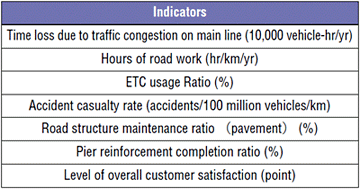 |
Contents -2005
|
 |
